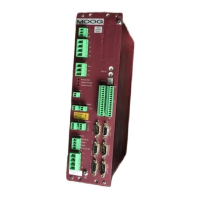T200 User's Manual SECTION 6: T200 FUNCTIONAL OVERVIEW
PAGE 6-18
6. Actual Position:- The position feedback can be monitored on TP1. This is scaled by the user-programmable Revs-
per-10V parameter. As before, the T200 contains a special function to zero-reference the present shaft position, such
that this position is taken as the zero-voltage-point of TP1 and TP2.
7. Position Error:- The position error can be monitored on TP1. This is scaled by the user-programmable Revs-per-
10V parameter.
8. Filtered Actual Velocity:- The actual position is filtered using a first order filter. The filtered velocity can be
monitored on TP1 and is scaled by the user-programmable RPM-per-10V parameter.
9. Observer Estimated Velocity:- The velocity-observer's estimation of present motor velocity can be monitored on
TP1. This is scaled by the user-programmable RPM-per-10V parameter.
10. Observer Estimated Error:- The velocity-observer's estimation of present motor position error can be monitored on
TP1. This quantity is un-scaled and is displayed in internal software units.
11. Point Diagnostic Channel 1:- The Point Motion Servo-drive can utilise the analog outputs as flexible output
channels. Note that the user MUST program TP1 as the Point Diagnostic Channel 1 parameter, in order to display
Point parameters.
TP1 Display Latencies for Software Variables
§ Measured process variables (actual velocity (item 3) and actual position (item 6)) are displayed within
200microseconds of their equivalent analog signals' sampling and conversion to digital form.
§ Derived process variables (all other items of the list above) are displayed within 550microseconds of the
commencement of the process cycle within which they were calculated.
6.5.4 TP2 Analog Output
The TP2 Analog Output is again used principally for diagnostic purposes. The same internal software variables can be
programmed on TP2 as on TP1, with the exception that item 11 corresponds to Point Diagnostic Channel 2 rather than
Point Diagnostic Channel 1.
TP2 Display Latencies for Software Variables are the same as those of TP1.
6.5.5 Limit Switch Function
Limit switches are used to stop the motion of the motor outside permissible machine operation limits. A Limit Switch is
active when no current flows in it's digital input.
1. Torque Mode:- Activation of the Clockwise Limit switch will inhibit torque production in a clockwise direction.
Likewise activation of the Counter-Clockwise Limit switch will inhibit torque production in a counter-clockwise
direction.
2. Velocity Mode:- Activation of the Clockwise Limit switch will cause the velocity command to be ramped down at
the rate Emergency-Deceleration-Rate, to zero velocity, and will subsequently clamp the velocity command to zero.
Motion in the Counter-Clockwise direction may still continue, in the absence of activation of the counterwise-
clockwise limit switch simultaneously! Likewise activation of the Counter-Clockwise Limit switch will cause the
velocity command to be ramped down at the rate Emergency-Deceleration-Rate, to zero velocity, and will
subsequently clamp the velocity command to zero. Motion in the Clockwise direction may still continue, in the
absence of activation of the clockwise limit switch simultaneously!
3. Position Mode:- The exact reaction to the Limit Switches depends upon the command generation mode:-
§ In Analog Position mode and Stepper Interface mode the reaction to the limit switches is the same as the
reaction in Velocity Mode.
Artisan Technology Group - Quality Instrumentation ... Guaranteed | (888) 88-SOURCE | www.artisantg.com

